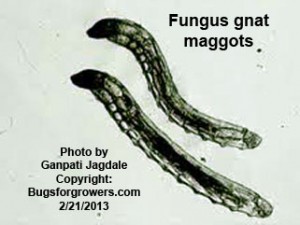Effective control of fungus gnats with entomopathogenic nematodes
Fungus gnats scientifically known as Bradysia spp are one of the most common pests of greenhouse ornamentals including African violets, carnations, chrysanthemums, cyclamen, lilies, geraniums, impatiens and poinsettias. Fungus gnat maggots (Fig. 1) primarily feed on fungi and organic matter but they can also feed on the plant roots and stems by chewing/stripping and tunneling, respectively.

Severely injured plants look unhealthy, discolored and eventually they dry. Fungus gnat maggots (Fig. 1) can also transmit fungal diseases such as Fusarium, Phoma, Pythium and Verticillium during feeding. Fungus gnat adults are nuisance to people and known to disseminate fungal spores from plant to plant when they migrate through the greenhouse.
Overlapping generations of fungus gnats in the greenhouse have made most control strategies difficult. Most growers generally rely on insecticides to manage fungus gnats in greenhouses but their use is restricted due to the detrimental effects on the environment and human health. Therefore, the environmentally safer and effective alternatives are required for the management of fungus gnats in greenhouses.
Three beneficial entomopathogenic nematodes including Steinernema feltiae and Heterorhabditis bacteriophora and Heterorhabditis indica have provided a potential alternative to chemical pesticides. The activity of these beneficial nematodes (also called as entomopathogenic nematodes) is strongly influenced by temperature because S. feltiae nematode is a cold adapted species whereas H. bacteriophora and H. indica are warm adapted species.
1. Beneficial nematode, Steinernema felitiae
Beneficial nematode, S. feltiae is a cold adapted nematode which is proved to be very effective in controlling fungus gnats in the European greenhouses where temperatures are maintained between 20 and 24oC. In these cool greenhouses, cold adapted S. feltiae nematodes when applied at the rate of 1 billion nematodes/ acre (2.5 X 105 infective juveniles/m2) can provide over 66% control of fungus gnats. However, if S. feltiae is applied at the same rate but at 25oC temperature it can only reduce 23% population of fungus gnats. This suggests that the S. feltiae works effectively against fungus gnats in the green houses where temperature is below 25oC or 77oF.
.
2. Beneficial nematode, Heterorhabditis bacteriophora
The warm adapted beneficial nematode H. bacteriophora can reduce about 52% population of fungus gnats infesting poinsettia when applied at the rate of 1 billion nematodes/ acre and at the temperature ranging from 25oC to 29oC. In contrast, when cold adapted S. feltiae (see above) applied at the same rate and temperature range, it can cause only 38% mortality of fungus gnats. This proves that the warm adapted entomopathogenic H. bacteriophora nematode will perform better than S. felitae against fungus gnats in the US greenhouses where temperatures are often very warm (≥30oC or 86oF) during summer.
3. Beneficial nematode Heterorhabditis indica
Another warm adapted beneficial nematode H. indica is considered as good as H. bacteriophora and better than S. felitae in reducing populations of fungus gnats when applied in the greenhouse at the rate of 1 billion nematodes/ acre and at temperatures above 25oC or 77oF. This nematode can reduce about 54% populations of fungus gnats infesting poinsettia in the greenhouse.
Literature: Read following papers for detail information on interaction between fungus gnats and beneficial nematodes
- Harris, M.A., Oetting, R.D., Gardner, W.A., 1995. Use of entomopathogenic nematodes and new monitoring technique for control of fungus gnats, Bradysia coprophila (Diptera: Sciaridae), in floriculture. Biological Control 5: 412-418.
- Jagdale, G.B., Casey, M.L., Grewal, P.S., Lindquist, R.K., 2004. Application rate and timing, potting medium and host plant effects on the efficacy of Steinernema feltiae against the fungus gnat, Bradysia coprophila, in floriculture. Biological Control 29: 296-305.
- Jagdale, G. B., Casey, M. L., Grewal, P. S. and Luis Cañas. 2007. Effect of entomopathogenic nematode species, split application and potting medium on the control of the fungus gnat, Bradysia difformis (Diptera : Sciaridae), in the greenhouse at alternating cold and warm temperatures. Biological Control. 43: 23-30.
- Kim, H.H., Choo, H.Y., Kaya, H.K., Lee, D.W., Lee, S.M., Jeon, H.Y., 2004. Steinernema carpocapsae (Rhabditida: Steinernematidae) as a biological control agent against the fungus gnat Bradysia agrestis (Diptera: Sciaridae) in propogation houses. Biocontrol Science and Technology 14: 171-183.
- Lindquist R., Piatkowski J. 1993. Evaluation of entomopathogenic nematodes for control of fungus gnat larvae. Bull. Int. Organiz. Biol. Integr. Control Noxious Animals and Plants. 16: 97-100.
- Tomalak, M., Piggott, S., Jagdale, G.B., 2005. Glasshouse applications. In: Grewal, P.S., Ehlers, R.-U., Shapiro-Ilan, D. (Eds.), Nematodes As Biocontrol Agents. CAB publishing, CAB International, Oxon, UK, pp. 147- 166.
